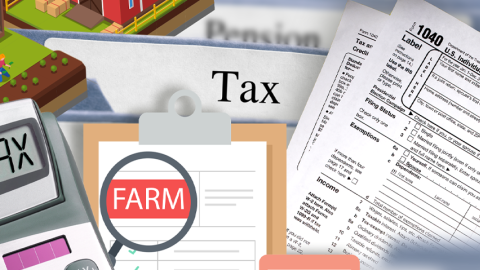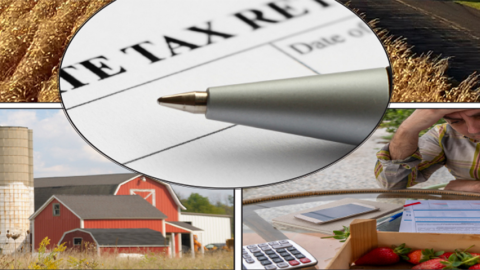Federal tax policy can affect the well-being of farm and rural households and the viability of farm operations. In recent years, Federal income taxes on both farm and nonfarm income accounted for nearly two-thirds of the total Federal tax share for farmers, while Social Security and self-employment taxes represented nearly a third of the total share. These taxes can impact differently based on farm household type. Beyond a farm operation's income, the tax code influences farm management and other decisions, such as capital purchases and dispositions, and farm estate planning. The tax code can also affect eligibility for Federal program payments because they are linked to measures of adjusted gross income.
The Federal tax code also influences the well-being of rural households. Rural households on average have lower incomes than urban households and are more likely to live in poverty. Through refundable tax credits, the tax code assists low-income families, particularly those with children.
USDA, Economic Research Service (ERS) researchers study features of Federal tax law, the effects of Federal taxes on agriculture and the broader rural economy, as well as the impact of significant tax reform and other tax proposals. ERS also conducts research related to the use of the Federal tax system for the delivery or targeting of farm program benefits, including income caps for farm program payment eligibility.
ERS research findings indicate:
- Two recent laws enacted temporary provisions to the Federal tax code: 1) the American Rescue Plan Act (ARPA) and 2) the Tax Cut and Jobs Act (TCJA). The expiration of these temporary provisions would increase farm households’ Federal income tax liabilities by $8.9 billion and estate tax liabilities by $647 million the year following expiration. The combined effect of sunsetting reduced individual income tax rates, increased standard deduction, a cap on State and local tax deductions, and the elimination of the personal exemptions would have the largest impact on all farm households except for very large farms identified as those with annual gross cash farm income above $5 million. For these very large farm households, the sunsetting of the qualified business income deduction would result in the largest increase in tax liabilities. For more information, see An Analysis of the Effect of Sunsetting Tax Provisions for Family Farm Households (February 2024) and the Amber Waves feature, "Farm households face larger tax liabilities when provisions of the Tax Cuts and Jobs Act of 2017 expire" (Amber Waves, March 2024).
- The American Families Plan (AFP)—announced on April 28, 2021—proposed changing the treatment of capital gains taxation on inherited assets. ERS researchers analyzed the AFP proposal and estimated that of the 32,174 family farm estates likely created in 2021, 1.1 percent would owe capital gains taxes at death, 18.2 percent would not owe capital gains taxes at death but could have deferred tax liability if the farm assets do not remain family owned and operated, and 80.7 percent would have no change to their capital gains tax liability. For more information, see The Effect on Family Farms of Changing Capital Gains Taxation at Death (September 2021).
- The Tax Cuts and Jobs Act (TCJA)—enacted in December 2017 and amended in March 2018 by the Consolidated Appropriations Act of 2018—reformed multiple provisions within the tax code. ERS estimated the impact of TCJA on farm households using data from USDA's Agricultural Resource Management Survey (ARMS) and an individual tax model developed by ERS researchers. ERS estimated that if the TCJA had been used in 2016, farm households would have faced an average income tax rate of 13.9 percent versus the actual rate of 17.2 percent under the 2016 tax law. Additionally, in 2017 tax liabilities would have declined slightly for most farm sizes relative to the 2016 estimate. If the TCJA had been in effect in 2017, the average effective tax rate for family farm households would have been 12.8 percent. By comparison, the actual effective tax rate in 2017 was 16.8 percent. The average effective tax-rate estimates exclude self-employment taxes and include several tax credits—including the Child Tax Credit, Earned Income, Tax Credit, and Child and Dependent Care Tact credit. For more information, see Estimated Effects of the Tax Cuts and Jobs Act on Farms and Farm Households (June 2018) and "The Tax Cuts and Jobs Act would have lowered average income tax rates for farm households between 2016 and 2017" (Amber Waves, April 2019).
- Using data from USDA's 2023 Agricultural Resource Management Survey (ARMS), ERS estimated the impact of the estate tax for the roughly 41,104 farm estates likely to have been created in 2024. An estimated 407 farm estates—representing about 1percent of all estates—would have been required to file an estate-tax return. After accounting for tax adjustments, deductions, and exemptions, approximately 0.3 percent of farm estates were estimated to owe estate taxes in 2024. For more information, see Federal Estate Taxes.
- Past ERS research indicates Federal income tax credits—such as the Earned Income and Child Tax credits—have reduced the rural poverty rate by providing an income boost to low- and middle-income rural taxpayers. For more information, see Federal Tax Policies and Low-Income Rural Households (May 2011).
- Income eligibility caps for farm program payments specified in Farm Bill legislation typically affect only a small number of farm payment recipients each year, and the impact varies by farm type and organizational structure. For more information, see Effects of Reducing the Income Cap on Eligibility for Farm Program Payments (September 2007) and an update to this research in the Amber Waves feature (August 2016) "Farm Bill income cap for program payment eligibility affects few farms."



